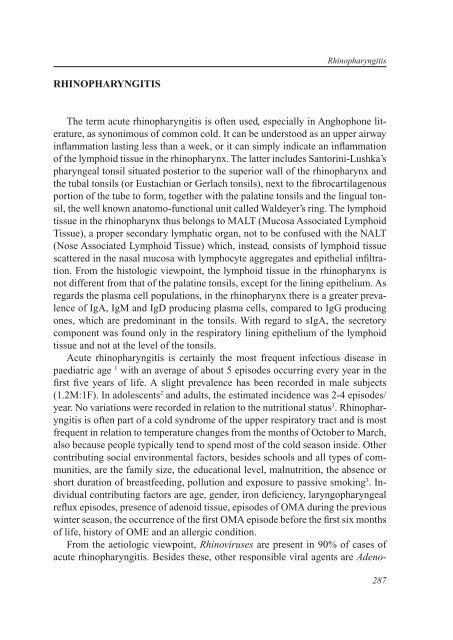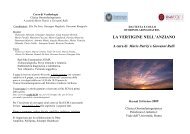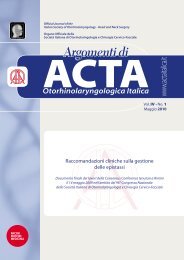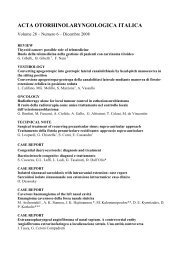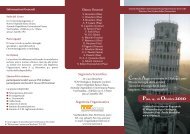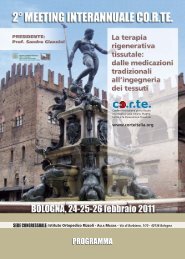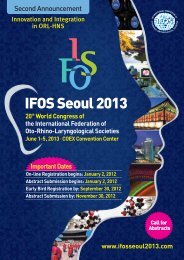- Page 1:
SOCIETÀ ITALIANA DI OTORINOLARINGO
- Page 4 and 5:
RELATORE DesiDerio Passàli Preside
- Page 7 and 8:
PreseNTaZioNe Presentazione Nel pre
- Page 9 and 10:
PreFaZioNe Prefazione Una sera, pri
- Page 11 and 12:
UNiTà riNoFariNGoTUBariCa Unità R
- Page 13 and 14:
Unità Rinofaringotubarica Fig. 3:
- Page 15 and 16:
Unità Rinofaringotubarica Fig. 5-1
- Page 17 and 18:
Fig. 9: strati superficiale, interm
- Page 19 and 20:
Fig. 13: anastonosi artero-venose (
- Page 21 and 22:
Unità Rinofaringotubarica bulinica
- Page 23 and 24:
Fig. 19: epitelio ciliato in pazien
- Page 25 and 26:
Unità Rinofaringotubarica rendono
- Page 27 and 28:
TUBA DI EUSTACHIO Unità Rinofaring
- Page 29 and 30:
Unità Rinofaringotubarica prevalen
- Page 31 and 32:
Unità Rinofaringotubarica aeree su
- Page 33 and 34:
Unità Rinofaringotubarica risalita
- Page 35 and 36:
Fig. 29: sostanza surfactante simil
- Page 37 and 38:
Unità Rinofaringotubarica muco. In
- Page 39:
Unità Rinofaringotubarica 29 Blues
- Page 42 and 43:
D. Passàli et al. o frontale la se
- Page 44 and 45:
D. Passàli et al. L’esame microb
- Page 46 and 47:
D. Passàli et al. Nella rinomanome
- Page 48 and 49:
D. Passàli et al. natura struttura
- Page 50 and 51:
D. Passàli et al. rizzato da un an
- Page 52 and 53:
D. Passàli et al. un controllo pos
- Page 54 and 55:
D. Passàli et al. l’olfattometri
- Page 56 and 57:
D. Passàli et al. dopo l’ottenim
- Page 58 and 59:
D. Passàli et al. 56 Fig. 17: test
- Page 60 and 61:
D. Passàli et al. Nel caso di perf
- Page 62 and 63:
D. Passàli et al. 27 Simola M, Mal
- Page 64 and 65:
D. Passàli et al. Sotto la comune
- Page 66 and 67:
D. Passàli et al. chiettasie non s
- Page 68 and 69:
D. Passàli et al. causare alterazi
- Page 70 and 71:
D. Passàli et al. 68 • di miglio
- Page 72 and 73:
D. Passàli et al. 70 Fig. 4: M.O.
- Page 74 and 75:
D. Passàli et al. 72 Fig. 9: M.E.
- Page 76 and 77:
D. Passàli et al. 74 Fig. 12: M.E.
- Page 79 and 80:
i BioFilM BaTTeriCi I biofilm batte
- Page 81 and 82:
I biofilm batterici fenotipo “bio
- Page 83 and 84:
I biofilm batterici Sono in continu
- Page 85 and 86:
I biofilm batterici 5. è evidenzia
- Page 87 and 88:
I biofilm batterici tra un numero e
- Page 89 and 90:
I biofilm batterici Una ulteriore s
- Page 91 and 92:
I biofilm batterici 27 Characklis W
- Page 93:
I biofilm batterici 80 Costerton J.
- Page 96 and 97:
D. Passàli et al. toferrina) e pro
- Page 98 and 99:
D. Passàli et al. all’ ICAM-1 tr
- Page 100 and 101:
D. Passàli et al. 98 5. risultano
- Page 102 and 103:
D. Passàli et al. proteina F1 a se
- Page 104 and 105:
D. Passàli et al. 102 Bibliografia
- Page 106 and 107:
D. Passàli et al. resistant Strept
- Page 108 and 109:
D. Passàli et al. patologia infett
- Page 110 and 111:
D. Passàli et al. ste cellule. La
- Page 112 and 113:
D. Passàli et al. secrezione nasal
- Page 114 and 115:
D. Passàli et al. battito ciliare.
- Page 116 and 117:
D. Passàli et al. T-helper che con
- Page 118 and 119:
D. Passàli et al. 116 Bibliografia
- Page 121 and 122:
le riNosiNUsiTi Le rinosinusiti inq
- Page 123 and 124:
Fig 2 : EP3OS: classificazione RSC
- Page 125 and 126:
Le rinosinusiti Sulla modalità di
- Page 127 and 128:
Fig. 5 a: complesso ostio meatale F
- Page 129 and 130:
Fig. 6 a: concha bullosa Fig. 6 B:
- Page 131 and 132:
Fig. 6 e: turbinato medio bilobato:
- Page 133 and 134:
Le rinosinusiti Fig. 8 a: rinosinus
- Page 135 and 136:
Fig. 8 e: una volta che gli eosinof
- Page 137 and 138:
Le rinosinusiti Fig. 8 i: microscop
- Page 139 and 140:
Le rinosinusiti Fig. 8 N: erosione
- Page 141 and 142:
Le rinosinusiti da aerobi e anaerob
- Page 143 and 144:
Le rinosinusiti Diagnosi clinica e
- Page 145 and 146:
Fig. 12: secrezione mucopurulenta a
- Page 147 and 148:
Fig. 14 a: TC coronale: concha bull
- Page 149 and 150:
Le rinosinusiti Fig. 14 e: TC assia
- Page 151 and 152:
Le rinosinusiti Edema, cicatrici o
- Page 153 and 154:
Le rinosinusiti Fig. 17 a: Cellulit
- Page 155 and 156:
Fig. 17 e: ascesso cerebrale in pol
- Page 157 and 158:
Le rinosinusiti Sono stati ricercat
- Page 159 and 160:
Le rinosinusiti Recenti studi sugge
- Page 161 and 162:
Le rinosinusiti quale si esercitere
- Page 163 and 164:
Le rinosinusiti Con queste premesse
- Page 165 and 166:
Tabella 2A. EP3OS: trattamento dell
- Page 167 and 168:
tab. 3B algoritmo per la gestione d
- Page 169 and 170:
Le rinosinusiti sinusale, ma solo a
- Page 171 and 172:
Le rinosinusiti cui l’identificaz
- Page 173 and 174:
Le rinosinusiti scopio e lo strumen
- Page 175 and 176:
Le rinosinusiti 28 Passariello C, S
- Page 177:
Le rinosinusiti 77 Kennedy DW, Zinr
- Page 180 and 181:
D. Passàli et al. Fig. 1: Storia n
- Page 182 and 183:
D. Passàli et al. il piccolo che v
- Page 184 and 185:
D. Passàli et al. Tra i fattori am
- Page 186 and 187:
D. Passàli et al. Lo studio condot
- Page 188 and 189:
D. Passàli et al. dell’allergia
- Page 190 and 191:
D. Passàli et al. Microbiologia Pe
- Page 192 and 193:
D. Passàli et al. Biofilm batteric
- Page 194 and 195:
D. Passàli et al. • nel rinofari
- Page 196 and 197:
D. Passàli et al. uditivo esterno
- Page 198 and 199:
D. Passàli et al. concluso che per
- Page 200 and 201:
D. Passàli et al. Brouwer et al. 9
- Page 202 and 203:
D. Passàli et al. Considerando il
- Page 204 and 205:
D. Passàli et al. Parallelamente s
- Page 206 and 207:
D. Passàli et al. l’otite compor
- Page 208 and 209:
D. Passàli et al. zae. Oltre il 30
- Page 210 and 211:
D. Passàli et al. il problema dell
- Page 212 and 213:
D. Passàli et al. gli antibiotici
- Page 214 and 215:
D. Passàli et al. l’orecchio med
- Page 216 and 217:
D. Passàli et al. La somministrazi
- Page 218 and 219:
D. Passàli et al. alla ipoacusia c
- Page 220 and 221:
D. Passàli et al. tuttora controve
- Page 222 and 223:
D. Passàli et al. 26 Sheahan P, Bl
- Page 224 and 225:
D. Passàli et al. 80 Bluestone CD.
- Page 226 and 227:
D. Passàli et al. infections faile
- Page 228 and 229:
D. Passàli et al. asma e poliposi
- Page 230 and 231:
D. Passàli et al. nasal drip, algi
- Page 232 and 233:
D. Passàli et al. Terapia medica P
- Page 234 and 235:
D. Passàli et al. Infine, lo scors
- Page 236 and 237:
D. Passàli et al. Tab. 3: Criteri
- Page 238 and 239: D. Passàli et al. po di trasporto
- Page 240 and 241: D. Passàli et al. inoltre, in circ
- Page 242 and 243: D. Passàli et al. 240
- Page 245 and 246: RHINOPHARYNGOTUBAL UNIT Rhinopharyn
- Page 247 and 248: Fig. 3: Nasal mucousa artero-venous
- Page 249 and 250: Fig. 6: Healthy nasal cilia Fig. 7:
- Page 251 and 252: Rhinopharyngotubal unit jects with
- Page 253 and 254: Fig. 10: Nasal surfactant Rhinophar
- Page 255 and 256: References Rhinopharyngotubal unit
- Page 257 and 258: THE DIAGNOSIS The diagnosis Medical
- Page 259 and 260: The diagnosis results, by using a v
- Page 261 and 262: Fig. 3: Nasal Mucociliary Transport
- Page 263: References The diagnosis 1 Ahlers A
- Page 266 and 267: D. Passàli et al. conducted in Nor
- Page 268 and 269: D. Passàli et al. 266 Fig. 2: O. M
- Page 270 and 271: D. Passàli et al. 268 Fig. 6: E. M
- Page 272 and 273: D. Passàli et al. 270 Fig. 10: E.
- Page 274 and 275: D. Passàli et al. 272 References 1
- Page 276 and 277: D. Passàli et al. 274 4. in the fo
- Page 278 and 279: D. Passàli et al. The proximity of
- Page 280 and 281: D. Passàli et al. 278 References 1
- Page 282 and 283: D. Passàli et al. 53 Galli J, Cal
- Page 284 and 285: D. Passàli et al. The knowledge of
- Page 286 and 287: D. Passàli et al. tive bacteria 20
- Page 290 and 291: D. Passàli et al. viruses (especia
- Page 292 and 293: D. Passàli et al. The old saying a
- Page 295 and 296: RHINOSINUSITIS Rhinosinusitis Class
- Page 297 and 298: Rhinosinusitis the changes in the s
- Page 299 and 300: Fig. 3: Mucus standard staining (GM
- Page 301 and 302: Rhinosinusitis Some laboratory test
- Page 303 and 304: Fig. 7: Axial CT scan showing a fro
- Page 305 and 306: RHINO-OTITIS Rhino-otitis Definitio
- Page 307 and 308: Rhino-otitis Among the individual f
- Page 309 and 310: Rhino-otitis Prevention A greater e
- Page 311 and 312: Rhino-otitis in the USA of practica
- Page 313 and 314: References Rhino-otitis 1 Paparella
- Page 315 and 316: RHINOBRONCHIAL SYNDROME Rhinobronch
- Page 317 and 318: Rhinobronchial syndrome The clinica
- Page 319 and 320: Rhinobronchial syndrome charge of t
- Page 322: Finito di stampare nel mese di apri


